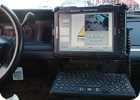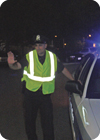

Wirelessly, security officers and public first responders can gain a view of an incident site and alarm information even while going to the situation.
Sorry Ben but there are many soft and hard solutions now available so that chief security officers, their staff members and law enforcement can gain more information faster or even be better seen at a scene.
My Inbox is chock-a-block with help. So let me share some with you.
No stranger to disasters big and small, New York City officials are rolling out new high-rise rules to establish so-called “safe floors.” And the security industry is responding. For instance, Diversified Security Solutions, a subsidiary of Henry Bros. Electronics, is aligned with Workspeed Notifications in a project called Workspeed Notify, an electronic evacuation notification solution that allows New York City building tenants to notify and account for their employees during an emergency evacuation.

At the scene of a nighttime incident, security officers and others can protect themselves by using reflective vests that meet ANSI standards, in effect for seven years.
Quick ID of Employees
The design pushes evacuation information instantly to thousands of employees/tenants through any electronic device including computers, cell phones, Blackberrys, etc. The electronic system also provides employees with the ability to respond, enabling the building to account for their employees/tenants in a crisis.The concept is labeled “mustering” and complements advances in mass notification, which itself goes beyond typical life safety systems.
“Technology has advanced to where we have automated two-way communications with large numbers of recipients in short time frames, which is ideal for notifying building occupants in the event of an emergency. The tool will enable NYC buildings to be Local Law 26 compliant while developing truly workable emergency plans that will make a major difference when a crisis occurs,” Derrick Chen of Workspeed told the Zalud Report.
Another wireless approach from AirVisual (and displayed at ISC Las Vegas back in March) is called IntelliViewer, what basically is a wireless video monitoring platform and mobile command system.
Using the IntelliViewer system, security professionals are able to overcome the challenge of how mobile personnel can access, monitor or control video images and other related security information to fully function while in the field, improving safety and the way they operate and respond. An open and secure platform offers full telemetry, enabling control over internal functions such as PTZ control, DVR set-up and programming and access control with advanced notification features – including the ability to send bookmarks with specific information related to alarm events.

Views and Monitoring on the Run
The system provides real-time views as well as archived video playback from surveillance cameras, GPS-tracking and alarm monitoring using a map-and-floor plan interface and offers personnel immediate access and sharing of critical data previously only available via the central station.While security wants to know who is in a building, and needs to see what is going on at a site before arriving, there is also the need at emergency situations to be seen, especially at night. Security, police, firefighters and other first responders often are at risk at nighttime emergencies.
It has been more than seven years since the ANSI standard for high visibility safety vests was approved; and many police departments now abide by those standards, according to Norman Bernson of Safety Flag Company of America. “It has taken awhile, and not all police departments are in compliance with ANSI/ISEA 107-1999,” he said.
Also aimed at private security officers, ANSI vests are more visible than both traditional fluorescent vests and newer fluorescent/reflective vests. The ANSI regulations stipulate minimum amounts of reflective and fluorescent materials for vests and establish performance specifications for visibility, both day and night. The standard applies to vests but not to safety belts. That may come in the future. Besides police, fire, security and EMS personnel, the vests are widely used by road construction contractors, utility workers and airport ramp workers.
“Anyone working around traffic, from crossing guards to parking lot security, should be wearing an ANSI-approved vest,” Bernson told the Zalud Report. “It is not worth the physical and legal risks not to use them.”
